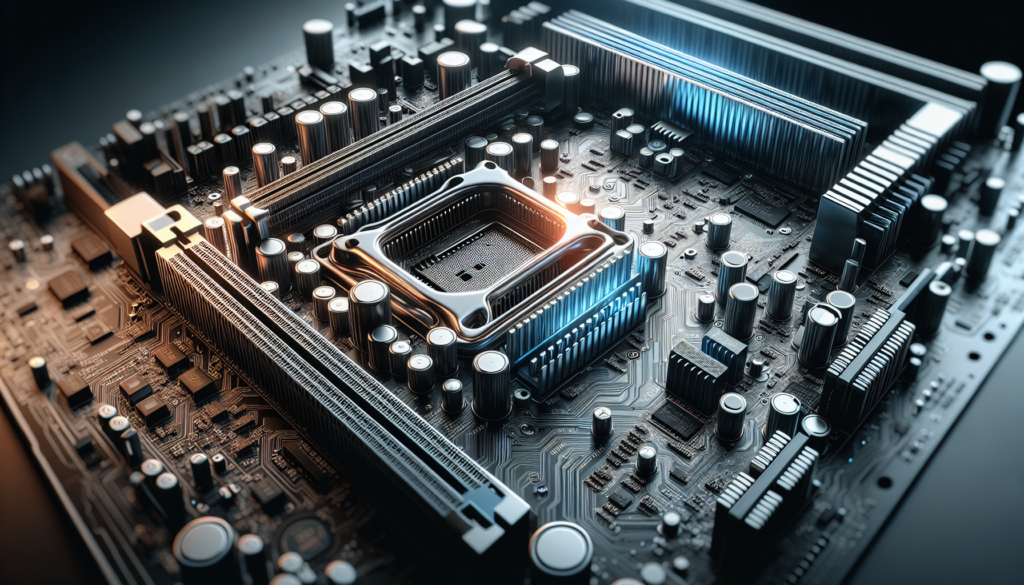In the world of computer hardware, expansion slots are like the secret tunnels that unlock a motherboard’s potential. These little wonders provide the gateway for additional components to be added to your system, giving it a much-needed boost in functionality and performance. From graphics cards to sound cards, expansion slots allow you to customize and upgrade your computer to suit your needs. So, if you’re curious to learn more about these mysterious slots and how they work their magic, keep reading to uncover the wonders of expansion slots and their role on motherboards.
This image is property of images.unsplash.com.
Expansion Slots on Motherboards
Definition of Expansion Slots
Expansion slots are specialized connectors found on motherboards that allow users to add additional peripheral devices or expansion cards to their computer systems. These slots provide a way to expand the functionality and capabilities of a motherboard, allowing users to customize their computers according to their specific needs and requirements.
Importance of Expansion Slots
Expansion slots play a vital role in the overall functionality and flexibility of a computer system. They enable users to enhance the capabilities of their machines, future-proof their systems, and avoid the need for purchasing new motherboards when upgrading their hardware.
Types of Expansion Slots
There are various types of expansion slots that have been developed over the years to accommodate different types of expansion cards and peripherals. Some of the most common types include PCI (Peripheral Component Interconnect), PCIe (PCI Express), AGP (Accelerated Graphics Port), ISA (Industry Standard Architecture), AMR (Audio Modem Riser), CNR (Communication and Networking Riser), PCI-X (PCI Extended), Mini PCIe (Mini PCI Express), CNVI (Client-to-Intel CNVi), and M.2.
Definition of Expansion Slots
Explanation of Expansion Slots
Expansion slots, as mentioned earlier, are specialized connectors located on the motherboard. These slots allow users to connect various expansion cards and peripherals to their computer systems. The expansion cards can provide additional functionality such as audio, video, networking, storage, or other specific features that are not included in the motherboard’s default configuration.
Purpose of Expansion Slots
The primary purpose of expansion slots is to expand the capabilities and flexibility of a computer system. By providing additional slots for expansion cards, users can tailor their computers to meet their specific needs. For example, a user may want to add a high-end graphics card for gaming or a dedicated sound card for better audio quality. The expansion slots enable the integration of these additional components seamlessly.
Basic Functionality of Expansion Slots
The basic functionality of expansion slots involves providing a physical connection between the expansion card and the motherboard. The slot itself acts as a bridge, allowing data to be transmitted between the expansion card and the motherboard’s chipset. This allows the expansion card to communicate with other components in the system, such as the CPU, memory, and other peripherals.
This image is property of images.unsplash.com.
Importance of Expansion Slots
Enhancing Functionality and Flexibility
Expansion slots are crucial for enhancing the functionality and flexibility of a computer system. They allow users to customize their machines according to their specific needs. Whether it’s adding more USB ports, upgrading the graphics capabilities, or improving networking capabilities, expansion slots provide the necessary interface for integrating these additional components seamlessly.
Future-Proofing
One significant advantage of expansion slots is the ability to future-proof a computer system. Technology is continually evolving, and new hardware components are regularly released. By having expansion slots available, users can easily upgrade their machines without having to replace the entire motherboard. This saves both time and money, as only the necessary expansion card needs to be added to keep up with the latest advancements.
Avoiding the Need for New Motherboards
The availability of expansion slots eliminates the need for users to purchase new motherboards when upgrading their machines. This is especially beneficial for users who have invested in high-quality motherboards with robust features and capabilities. Instead of starting from scratch, users can simply add the desired expansion card to their existing motherboard to enhance performance or functionality.
This image is property of images.unsplash.com.
Types of Expansion Slots
PCI (Peripheral Component Interconnect)
PCI, which stands for Peripheral Component Interconnect, is one of the most widely used expansion slot standards. It was first introduced in the early 1990s and has been prevalent in computer systems for decades. PCI slots are typically used for connecting various expansion cards, including sound cards, network cards, and video cards.
PCIe (PCI Express)
PCI Express, commonly referred to as PCIe, has largely replaced the older PCI slots due to its numerous advantages. PCIe is significantly faster than PCI and offers better bandwidth, making it ideal for high-performance devices like graphics cards and solid-state drives (SSDs). PCIe slots come in different sizes, including x1, x4, x8, and x16, depending on the transfer speed requirements of the expansion card.
AGP (Accelerated Graphics Port)
Accelerated Graphics Port (AGP) was specifically designed for connecting graphics cards to the motherboard. AGP slots provided faster and more efficient data transfer between the CPU and the graphics card compared to regular PCI slots. However, AGP slots are now considered obsolete, with the advent of the more advanced PCIe technology.
ISA (Industry Standard Architecture)
Industry Standard Architecture (ISA) slots were prevalent in older computer systems, primarily from the 1980s and early 1990s. ISA slots supported a wide range of expansion cards, including sound cards, modems, and network cards. However, the slow data transfer speed and limited capabilities of ISA slots rendered them obsolete with the introduction of newer and faster technologies.
AMR (Audio Modem Riser)
Audio Modem Riser (AMR) slots were designed to provide an integrated sound and modem solution for computer systems. AMR slots allowed for the easy integration of audio and modem cards directly onto the motherboard, saving space and simplifying installation. However, AMR slots are no longer commonly found on modern motherboards, as integrated audio and modems are now the norm.
CNR (Communication and Networking Riser)
Communication and Networking Riser (CNR) slots were similar to AMR slots and aimed to provide integrated communication and networking solutions. CNR slots allowed users to add network adapters, modems, and other communication devices directly onto the motherboard. Like AMR, CNR slots have become obsolete due to the widespread availability of integrated networking capabilities on modern motherboards.
PCI-X (PCI Extended)
PCI Extended (PCI-X) slots were developed as an extension of the original PCI standard to provide faster data transfer speeds for server and workstation applications. PCI-X slots offered higher bandwidth and larger bus widths, making them suitable for high-performance peripherals and expansion cards. However, PCI-X slots are now being phased out in favor of the more advanced PCIe technology.
Mini PCIe (Mini PCI Express)
Mini PCI Express (Mini PCIe) slots are smaller versions of the standard PCIe slots. They are commonly used in laptops and small form factor systems, offering the same functionality as their larger counterparts. Mini PCIe slots are typically used for connecting wireless network cards, solid-state drives (SSDs), and other compact expansion cards.
CNVI (Client-to-Intel CNVi)
Client-to-Intel CNVi (CNVI) slots were introduced by Intel to provide enhanced wireless connectivity on motherboards. CNVI slots are designed to accommodate compatible wireless modules, offering faster and more reliable Wi-Fi and Bluetooth connectivity. This allows users to enjoy seamless wireless networking capabilities without the need for additional USB devices or expansion cards.
M.2
M.2 slots are the latest addition to the expansion slot family, offering high-speed connections for various expansion cards. M.2 slots support a wide range of devices, including solid-state drives (SSDs), Wi-Fi cards, Bluetooth modules, and more. M.2 slots come in different sizes and support different types of connectors, allowing for maximum versatility and performance.
In conclusion, expansion slots on motherboards provide a crucial avenue for users to expand and customize their computer systems. These slots enable the addition of various expansion cards and peripherals, enhancing functionality, flexibility, and future-proofing capabilities. With advancements in technology, different types of expansion slots have emerged over the years, catering to specific needs and requirements. From the traditional PCI and AGP slots to the more advanced PCIe and M.2 variants, expansion slots continue to play a vital role in maximizing the potential of modern computer systems.





